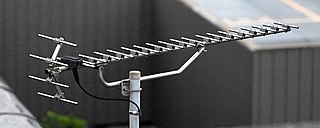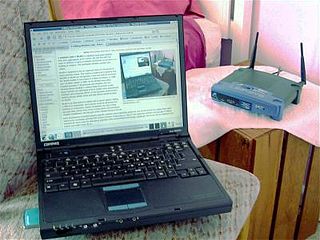
Wireless broadband is a telecommunications technology that provides high-speed wireless Internet access or computer networking access over a wide area. The term encompasses both fixed and mobile broadband.

Ultra high frequency (UHF) is the ITU designation for radio frequencies in the range between 300 megahertz (MHz) and 3 gigahertz (GHz), also known as the decimetre band as the wavelengths range from one meter to one tenth of a meter. Radio waves with frequencies above the UHF band fall into the super-high frequency (SHF) or microwave frequency range. Lower frequency signals fall into the VHF or lower bands. UHF radio waves propagate mainly by line of sight; they are blocked by hills and large buildings although the transmission through building walls is strong enough for indoor reception. They are used for television broadcasting, cell phones, satellite communication including GPS, personal radio services including Wi-Fi and Bluetooth, walkie-talkies, cordless phones, satellite phones, and numerous other applications.
Air-ground radiotelephone service is a system that allows voice calls and other communication services to be made from an aircraft to either a satellite or land-based network. The service operates via a transceiver mounted in the aircraft on designated frequencies. In the US these frequencies have been allocated by the Federal Communications Commission.
United States Cellular Corporation is an American mobile network operator. Its stock is publicly traded, but Telephone and Data Systems Inc. owns a controlling stake. The company was formed in 1983 and is headquartered in Chicago, Illinois. UScellular is the fifth largest wireless carrier in the United States, with 4.5 million subscribers in 21 states as of October 31, 2024.

Sprint Corporation was an American telecommunications company. Before being acquired by T-Mobile US on April 1, 2020, it was the fourth-largest mobile network operator in the United States, serving 54.3 million customers as of June 30, 2019. The company also offered wireless voice, messaging, and broadband services through its various subsidiaries under the Boost Mobile and Open Mobile brands and wholesale access to its wireless networks to mobile virtual network operators.

A spectrum auction is a process whereby a government uses an auction system to sell the rights to transmit signals over specific bands of the electromagnetic spectrum and to assign scarce spectrum resources. Depending on the specific auction format used, a spectrum auction can last from a single day to several months from the opening bid to the final winning bid. With a well-designed auction, resources are allocated efficiently to the parties that value them the most, the government securing revenue in the process. Spectrum auctions are a step toward market-based spectrum management and privatization of public airwaves, and are a way for governments to allocate scarce resources.

MediaFLO was a technology developed by Qualcomm for transmitting audio, video and data to portable devices such as mobile phones and personal televisions, used for mobile television. In the United States, the service powered by this technology was branded as FLO TV.
Cellular frequencies in the United States are allocated by the US Federal Communications Commission. As cellular mobile telephone technology has evolved over time, periodically bands of frequencies are reassigned from other radio services. Companies wishing to provide cellular services in a geographic region compete for the right to license radio spectrum in spectrum auctions. Different cellular companies in the same region may use different levels of cellular technology and different parts of the radio spectrum. In addition to radio frequencies used to connect handsets with cellular base stations, other parts of the radio spectrum are used to interconnect base stations and the wired telephone network. Some frequency bands may be vulnerable to interference by existing services in adjacent frequency bands, such as UHF television broadcasting.
Advanced Wireless Services (AWS) is a wireless telecommunications spectrum band used for mobile voice and data services, video, and messaging. AWS is used in the United States, Argentina, Canada, Colombia, Mexico, Chile, Paraguay, Peru, Ecuador, Trinidad and Tobago, Uruguay and Venezuela. It replaces some of the spectrum formerly allocated to Multipoint Multichannel Distribution Service (MMDS), sometimes referred to as Wireless Cable, that existed from 2150 to 2162 MHz.
The United States 700 MHz FCC wireless spectrum auction, officially known as Auction 73, was started by the Federal Communications Commission (FCC) on January 24, 2008 for the rights to operate the 700 MHz radio frequency band in the United States. The details of process were the subject of debate among several telecommunications companies, including Verizon Wireless, AT&T Mobility, as well as the Internet company Google. Much of the debate swirled around the open access requirements set down by the Second Report and Order released by the FCC determining the process and rules for the auction. All bidding was required by law to commence by January 28.

Julius Genachowski is an American lawyer and businessman. He became the Federal Communications Commission Chairman on June 29, 2009. On March 22, 2013, he announced he would be leaving the FCC in the coming weeks. On January 6, 2014, it was announced that Genachowski had joined The Carlyle Group. He transitioned from Partner and Managing Director to Senior Advisor in early 2024.

Freedom Mobile, a Canadian wireless telecommunications provider owned by Québecor, holds a 6% market share of the Canadian wireless market, primarily concentrated in urban areas of Ontario, British Columbia, Alberta, and Manitoba. As the fourth-largest wireless carrier in Canada, Freedom Mobile serves 2,290,497 subscribers as of November 30, 2022. In addition to mobile phone plans, Freedom also offers home internet and TV services.
In India, the Department of Telecommunications (DoT) conducts auctions of licenses for electromagnetic spectrum. India was among the early adopters of spectrum auctions beginning auctions in 1994.
The digital dividend refers to the radio spectrum which is released in the process of digital television transition. When television broadcasters switch from analog TV to digital-only platforms, part of the electromagnetic spectrum that has been used for broadcasting will be freed-up because digital television needs less spectrum than analog television, due to lossy compression. One reason is that new digital video compression technology can transmit numerous digital subchannels using the same amount of spectrum used to transmit one analog TV channel. However, the primary reason is that digital transmissions require much less of a guard band on either side, since they are not nearly as prone to RF interference from adjacent channels. Because of this, there is no longer any need to leave empty channels to protect stations from each other, in turn allowing stations to be repacked into fewer channels, leaving more contiguous spectrum to be allocated for other wireless services.
The 2016 United States wireless spectrum auction, officially known as Auction 1001, allocated approximately 100 MHz of the United States Ultra High Frequency (UHF) spectrum formerly allocated to UHF television in the 600 MHz band. The spectrum auction and subsequent reallocations were authorized by Title VI of the payroll tax cut extension passed by the United States Congress on February 17, 2012.
Pakistan's next generation mobile spectrum auction for the electromagnetic spectrum's licenses was held on 23 April 2014 by Pakistan Telecommunication Authority.

Airtel India is the second largest provider of mobile telephony and third largest provider of fixed telephony in India, and is also a provider of broadband and subscription television services. The brand is operated by several subsidiaries of Bharti Airtel, with Bharti Hexacom and Bharti Telemedia providing broadband fixed line services and Bharti Infratel providing telecom passive infrastructure service such as telecom equipment and telecom towers. Currently, Airtel provides 5G, 4G and 4G+ services all over India. Currently offered services include fixed-line broadband, and voice services depending upon the country of operation. Airtel had also rolled out its VoLTE technology across all Indian telecom circles.

The C band is a designation by the Institute of Electrical and Electronics Engineers (IEEE) for a portion of the electromagnetic spectrum in the microwave range of frequencies ranging from 4.0 to 8.0 gigahertz (GHz). However, the U.S. Federal Communications Commission C band proceeding and auction, designated 3.7–4.2 GHz as C band. The C band is used for many satellite communications transmissions, some cordless telephones, as well as some radar and weather radar systems.

DISH Wireless L.L.C., doing business as Boost Mobile, is an American telecommunications company and wholly owned subsidiary of EchoStar Corporation. Boost Mobile is the fourth largest wireless carrier in the United States. Together with its sister brands Gen Mobile and Ting Mobile, it serves 7 million subscribers as of September 30, 2024.










